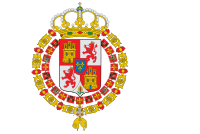The Pacte de Famille (French pronunciation: [pakt də famij], Family Compact; Spanish language: Pacto de Familia ) is one of three separate, but similar alliances between the Bourbon kings of France and Spain.
The first Pacte de Famille[]
The first of these (Primer Pacto de Familia) was made on November 7, 1733 by King Philip V of Spain and King Louis XV of France in the Treaty of the Escorial.
Philip V was the grandson of Louis XIV and had become the first Bourbon King of Spain in 1700 upon the extinction of Spanish Habsburgs. After a long war, the War of the Spanish Succession, he was recognized as king by other European powers in the Treaty of Utrecht with the condition that the thrones of Spain and France never be united. In addition, Spanish possessions in Italy were ceded to the surviving branch of the House of Habsburg.
Louis XV was Philip's nephew. He had married Maria Leszczyńska, the daughter of King Stanislaus I of Poland. Because of this marriage alliance France became involved in the War of the Polish Succession in 1733.
Philip V formed a plan to use this conflict to win back lost territory in Italy for his sons. He allied Spain to France. Because of his close relationship with Louis XV their alliance became known as the Family Compact. Louis failed to restore Stanislas to the Polish throne, but the Bourbons would gain the Duchy of Lorraine (for France) and the Kingdoms of Naples and Sicily (for Charles, the third son of King Philip V of Spain) from his conflict.
The second Pacte de Famille[]
The second Family Compact was made on October 25, 1743 again by King Philip V of Spain and King Louis XV of France in the Treaty of Fontainebleau.
This pact was signed in the middle of the War of Austrian Succession, and most of its clauses had to do with the conduct of the war. The result was the expansion of Spanish influence in Italy when Philip V's fourth son Philip, became in 1748 Duke of Parma, Piacenza and Guastalla.
The third Pacte de Famille[]
The third Family Compact was made on 15 August 1761 by King Charles III of Spain and Louis XV in the Treaty of Paris.
Charles III was the son of Philip V, making him Louis's first cousin. At this time France was fighting the Seven Years' War against Great Britain. Charles's alliance reversed the policy of his predecessor, Ferdinand VI, who wished to keep Spain out of the war. The agreement involved Spain's allies Naples and Tuscany. When Spain became involved, the British occupied the Philippines and Cuba. Charles III recovered these possessions in the Treaty of Paris (1763), but ceded Florida to the British.
Later Franco-Spanish Pacts[]
- On April 12, 1779 France and Spain signed the Treaty of Aranjuez (1779), by which Spain joined the American Revolutionary War against Great Britain. This Pact was seen as a renewal of the third Pacte de Famille, and therefore not named the fourth Pacte de Famille.
- In August 1796 Manuel Godoy negotiated and signed the Second Treaty of San Ildefonso with France which required that Spain declare war on Great Britain. This treaty can not be considered a Family Compact, since the French Bourbons at that time had been killed or fled France because of the French revolution.
External links[]
- François Velde, The Pacte de Famille of 1761. In English, includes French-language text of the Pact.
The original article can be found at Pacte de Famille and the edit history here.

